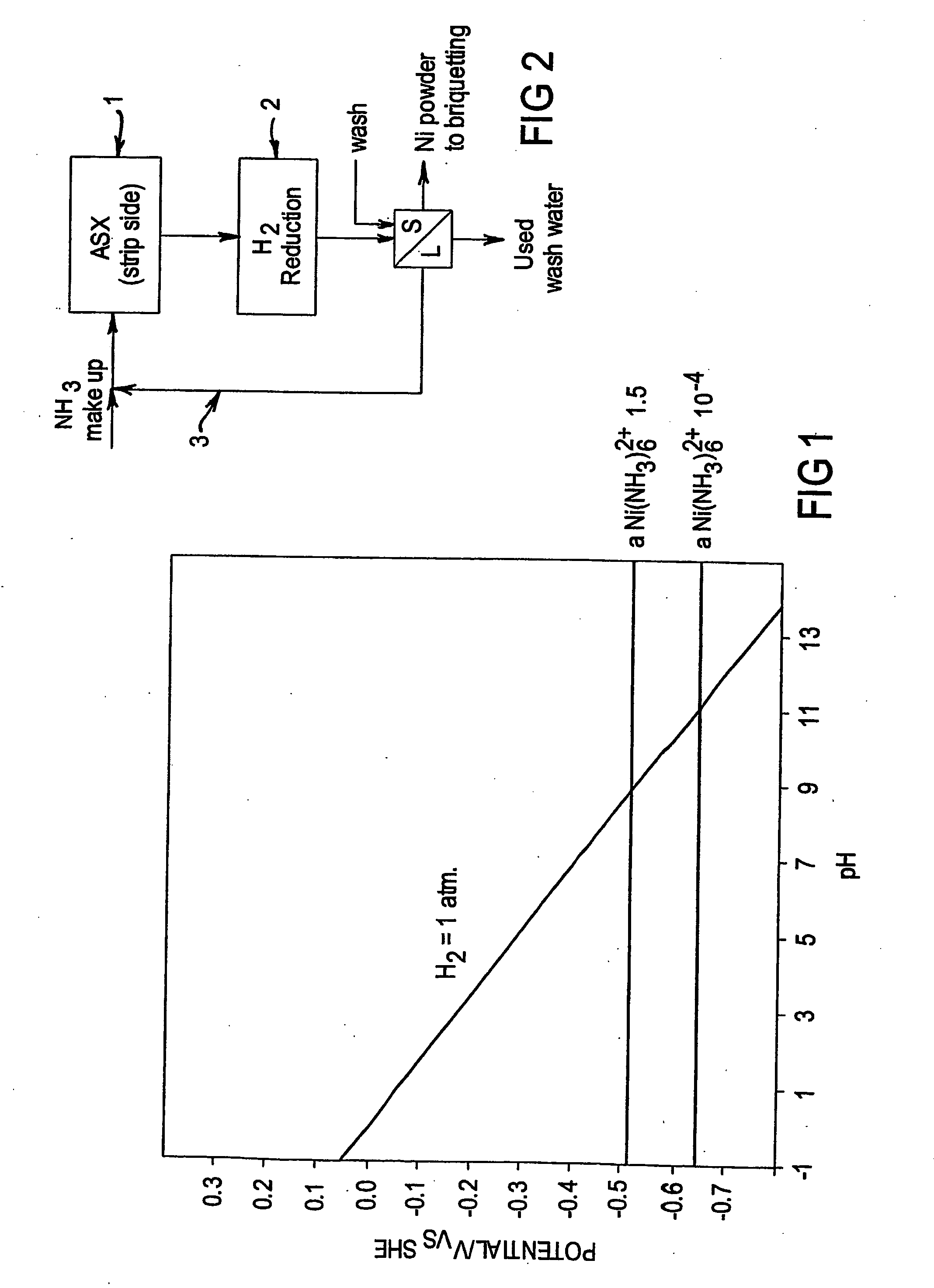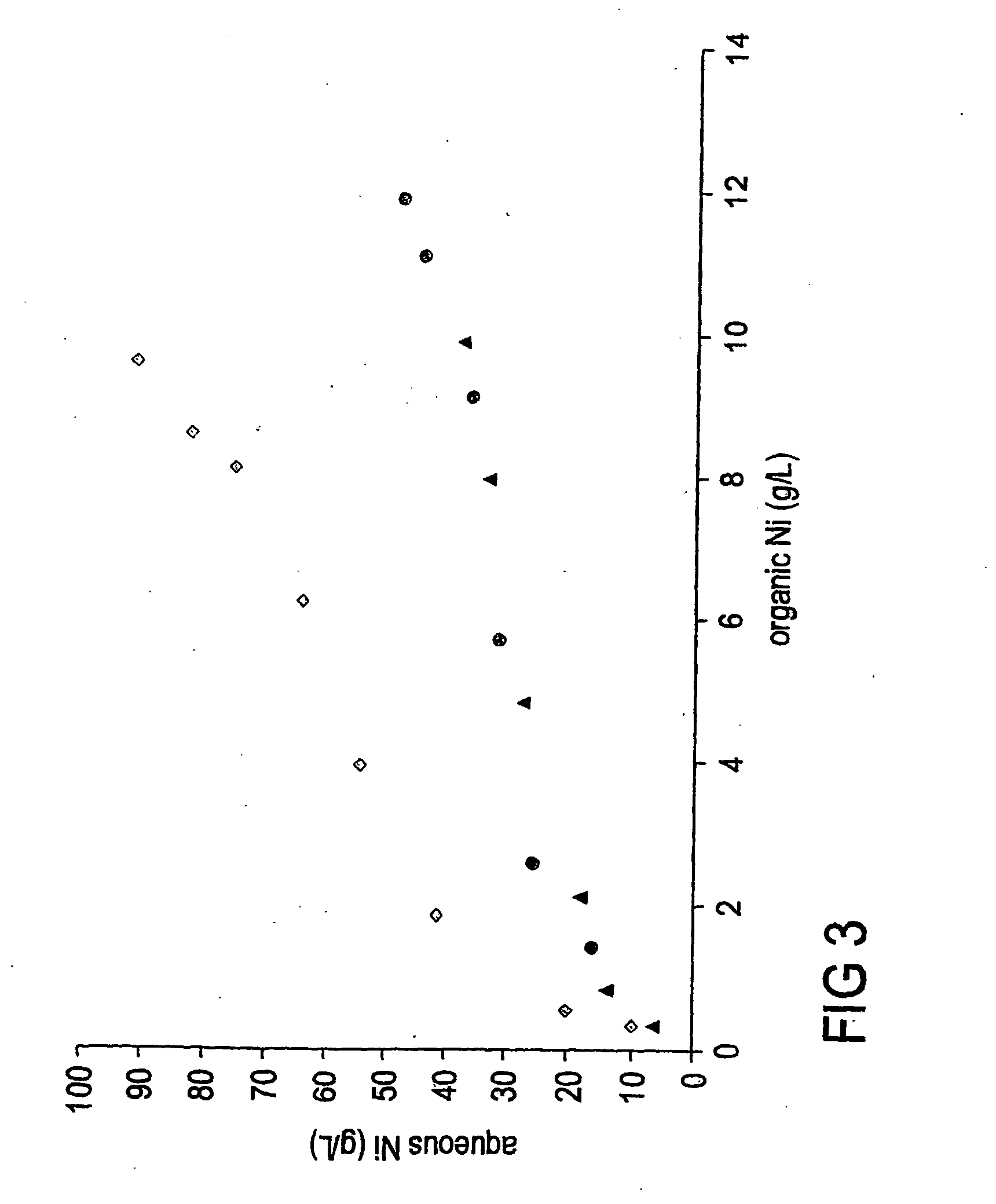Integrated ammoniacal solvent extraction and hydrogen reduction of nickel
a technology of ammoniacal solvent and nickel, which is applied in the direction of nickel compounds, inorganic chemistry, separation processes, etc., can solve the problems of nickel ammines' stability decline, no known commercial processes where nickel is recovered by hydrogen reduction, and precipitation of salts and hydroxides. , to achieve the effect of high quality
- Summary
- Abstract
- Description
- Claims
- Application Information
AI Technical Summary
Benefits of technology
Problems solved by technology
Method used
Image
Examples
example 1
[0059] Test work was conducted in order to investigate whether nickel could be stripped from a typically loaded organic phase produced in a solvent extraction process as described in AU 605867 using a high strength ammoniacal ammonium sulphate strip solution rather than an ammoniacal ammonium carbonate strip solution.
[0060] Stripping isotherms generated using strip liquor containing two different sulphate concentrations showed that nickel may be stripped from the loaded organic phase using ammoniacal ammonium sulphate. The nickel loaded organic phase was formed using 2-hydroxy-5-t-nonyl acetophenoneoxime reagent modified by an alcohol in an aliphatic or aromatic kerosene type carrier.
[0061] The results for the strip isotherms obtained using the ammoniacal ammonium sulphate strip liquor at two different sulphate concentrations are given in Table 2 and FIG. 3.
TABLE 2Table 2. Data obtained for the stripping of loaded ASX organicphase with ammoniacal ammonium sulphate solution at tw...
example 2
[0062] This test was carried out to illustrate the concept of integration of the stripping of nickel from the organic phase following an ammoniacal solvent extraction process using a concentrated ammonia ammonium sulphate solution followed by hydrogen reduction to produce nickel metal.
[0063] A solution of nickel hexammine sulphate and free ammonia was prepared by dissolving 358.3 g of NiSO4.6H2O crystals in 641.7 g of 25% w / w aqueous ammonia solution. The solution by calculation contained 80.0 g of Ni and 160.4 g of NH3. This corresponds to a NH3:Ni mole ratio of 6.9:1. A sample was found by assay to contain 94 g / L of Ni. 994 g of this solution was charged into a 2 L batch 316 stainless steel autoclave equipped with a borosilicate glass liner, cooling coils, thermocouple well and agitator. The autoclave was sealed, agitation at 214 rpm started, purged with high purity nitrogen gas and external electrical heating applied to raise the temperature of the solution to 185° C. The total ...
example 3
[0064] This test was carried out to illustrate the concept of integration of the stripping of nickel from the organic phase following an ammoniacal solvent extraction process using a concentrated ammonia ammonium carbonate solution followed by hydrogen reduction to produce nickel metal.
[0065] A solution of nickel, carbon dioxide and free ammonia was prepared by dissolving 250 g of basic nickel carbonate filter cake (containing 24% Ni by weight) in 868 g of 28% w / w aqueous ammonia solution. The solution by calculation contained 57.6 g of Ni and 243 g of NH3. This corresponds to a theoretical Ni:NH3 mole ratio of 1:14.6. A sample was found by assay to contain 54 g / L of Ni and 190 g / L of ammonia, corresponding to an actual ratio of 1:12.1, Ni:NH3. 984 g of this solution was charged into a 2 L batch 316 stainless steel autoclave equipped with a borosilicate glass liner, cooling coils, thermocouple well and agitator. The ports and pressure gauge were heated to prevent ammonium carbonate...
PUM
| Property | Measurement | Unit |
|---|---|---|
| Concentration | aaaaa | aaaaa |
| Concentration | aaaaa | aaaaa |
| Concentration | aaaaa | aaaaa |
Abstract
Description
Claims
Application Information
 Login to View More
Login to View More - R&D
- Intellectual Property
- Life Sciences
- Materials
- Tech Scout
- Unparalleled Data Quality
- Higher Quality Content
- 60% Fewer Hallucinations
Browse by: Latest US Patents, China's latest patents, Technical Efficacy Thesaurus, Application Domain, Technology Topic, Popular Technical Reports.
© 2025 PatSnap. All rights reserved.Legal|Privacy policy|Modern Slavery Act Transparency Statement|Sitemap|About US| Contact US: help@patsnap.com



